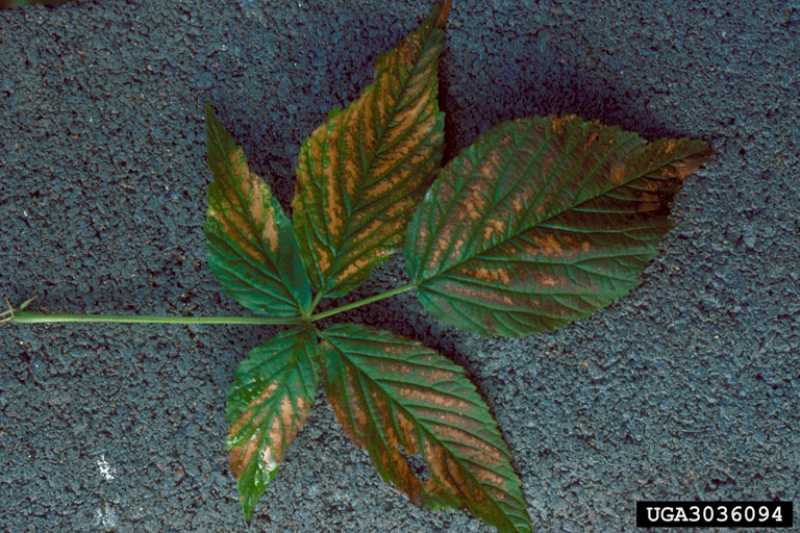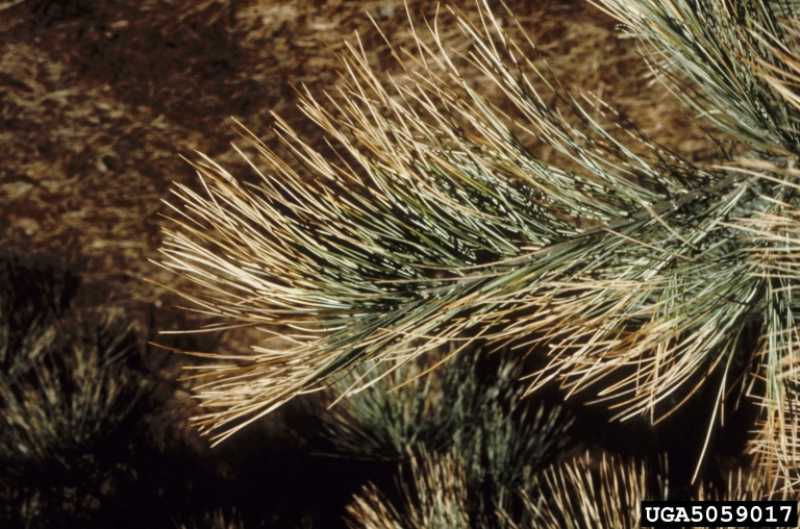 |
Air pollution (sulfur dioxide) on blackberry (Rubus). R. L. Anderson, USFS, Bugwood.org |
Sulfur dioxide is primarily a result of fossil fuel burning for electricity generation and to a lesser degree, the processing of steel and other ores. Damage to plants by sulfur dioxide (S02) has formerly been concentrated around the industrial sources of the pollutant. Where such emitters of this pollutant have either closed or erected tall stacks, intense local damage has ceased, and revegetation has begun. When sulfur dioxide enters the atmosphere from taller stacks, it becomes more widely distributed and greatly diluted before reaching ground level. Therefore, acute injury by sulfur dioxide has become less common.
Symptoms and Diagnosis
Acute foliar injury by sulfur dioxide is indicated by bleached or pigmented (tan to reddish brown or dark brown, depending on species) necrotic interveinal areas on broad-leaved plants and chlorotic spots and bands or brown tips on needles of conifers. Young leaves that have attained full size are generally most sensitive.
Life Cycle
Sulfur dioxide causes injury when it and its sulfite derivative are absorbed faster than they are detoxified. The gas is oxidized successively to sulfite and sulfate, which interfere with photosynthesis and energy metabolism. Sulfite is about 30 times more toxic than sulfate. The latter, in modest doses, is used as a sulfur source for normal growth and development. Plants injured by sulfur dioxide have an abnormally high foliar sulfur content for a time, which is diagnostically useful if appropriate standards are available for comparison.
Plants vary widely in tolerance to sulfur dioxide because of the differences in the efficiency with which they absorb the gas and the plant’s ability to detoxify the pollutant and dispose of excess sulfur. Much sulfur absorbed by leaves is translocated to other plant parts, thus diluting it.
Trees growing in shade show less damage than trees growing in full sun.
Integrated Pest Management Strategies
1. Maintain plant vigor. Plants in good health resist all type of injury better than weakened plants. Water in times of drought. Fertilize when needed. Soil should be porous, well-draining, and not compacted.
2. Select plants. Select plants tolerant of air pollutants.
3. Reduce emissions. Reduce emissions from the source when possible.
Organic Strategies
Strategies 2 and 3 are strictly organic approaches. Using an appropriate organic fertilizer would be a viable organic approach to Strategy 1.
More images:
 |
| Sulfur dioxide damage on pine needles (Pinus spp.). J. O'Brien, USFS, Bugwood.org |
|
|